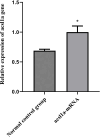Therapeutic potential of a choline-zinc-vitamin E nutraceutical complex in ameliorating thioacetamide-induced nonalcoholic fatty liver pathology in zebrafish
- PMID: 40392901
- PMCID: PMC12091810
- DOI: 10.1371/journal.pone.0324164
Therapeutic potential of a choline-zinc-vitamin E nutraceutical complex in ameliorating thioacetamide-induced nonalcoholic fatty liver pathology in zebrafish
Abstract
Choline has been proven to be effective in maintaining liver function. However, the effect of choline, in combination with other nutrients, on the improvement of non-alcoholic fatty liver disease (NAFLD) remains unclear. This study aimed to investigate the potential effect of the nutraceutical complex containing choline bitartrate, zinc citrate, and dl-α-Tocopheryl acetate on NAFLD in the zebrafish model. The NAFLD model was induced in zebrafish by administering thioacetamide. Experimental groups were established, including a normal control group, the model control group, the positive control group, the nutraceutical complex intervention group, and the choline bitartrate alone intervention group. The intervention was administered to the zebrafish in a water-soluble form, while the positive control group received polyene phosphatidylcholine at a concentration of 50.0 μg/mL. Notably, the protective effect of the nutraceutical complex against NAFLD is more pronounced than that observed with choline bitartrate supplementation alone. The results of transcriptomics and quantitative real-time PCR showed that the potential mechanisms underlying the effects of the nutraceutical complex might involve the upregulation of acacia, acsl1a, fbp2 gene expression, and the downregulation of tbc1d1 gene expression. These results were further validated by western blotting and overexpression experiments. Our findings indicated that choline bitartrate, zinc citrate, and dl-α-Tocopheryl acetate can help improve NAFLD. The results of this study provide evidence for the application of the nutraceutical complex in the improvement of NAFLD.
Copyright: © 2025 Cao et al. This is an open access article distributed under the terms of the Creative Commons Attribution License, which permits unrestricted use, distribution, and reproduction in any medium, provided the original author and source are credited.
Conflict of interest statement
Xiaoqing Li and Rui Wang are currently employees of Opella. Bingbing Cao, Jiali Zhou, Bo Xia, Yiqiao Xu and Chunqi Li are employees of Hunter Biotechnology, Inc. which performed the study by order of Opella. This does not alter our adherence to PLOS ONE policies on sharing data and materials.
Figures






Similar articles
-
Protective effects and mechanisms of total alkaloids of Rubus alceaefolius Poir on non‑alcoholic fatty liver disease in rats.Mol Med Rep. 2014 Oct;10(4):1758-64. doi: 10.3892/mmr.2014.2403. Epub 2014 Jul 21. Mol Med Rep. 2014. PMID: 25051256
-
Treatment of Non-Alcoholic Steatosis: Preclinical Study of a New Nutraceutical Multitarget Formulation.Nutrients. 2020 Jun 18;12(6):1819. doi: 10.3390/nu12061819. Nutrients. 2020. PMID: 32570937 Free PMC article.
-
Zinc supplementation attenuates thioacetamide-induced liver injury and hyperglycemia in mice.Biol Trace Elem Res. 2003 May;92(2):173-80. doi: 10.1385/BTER:92:2:173. Biol Trace Elem Res. 2003. PMID: 12746576
-
Nutraceutical Approach to Non-Alcoholic Fatty Liver Disease (NAFLD): The Available Clinical Evidence.Nutrients. 2018 Aug 23;10(9):1153. doi: 10.3390/nu10091153. Nutrients. 2018. PMID: 30142943 Free PMC article.
-
A Comparison of the Gene Expression Profiles of Non-Alcoholic Fatty Liver Disease between Animal Models of a High-Fat Diet and Methionine-Choline-Deficient Diet.Molecules. 2022 Jan 27;27(3):858. doi: 10.3390/molecules27030858. Molecules. 2022. PMID: 35164140 Free PMC article. Review.
References
MeSH terms
Substances
LinkOut - more resources
Full Text Sources
Medical
Molecular Biology Databases

